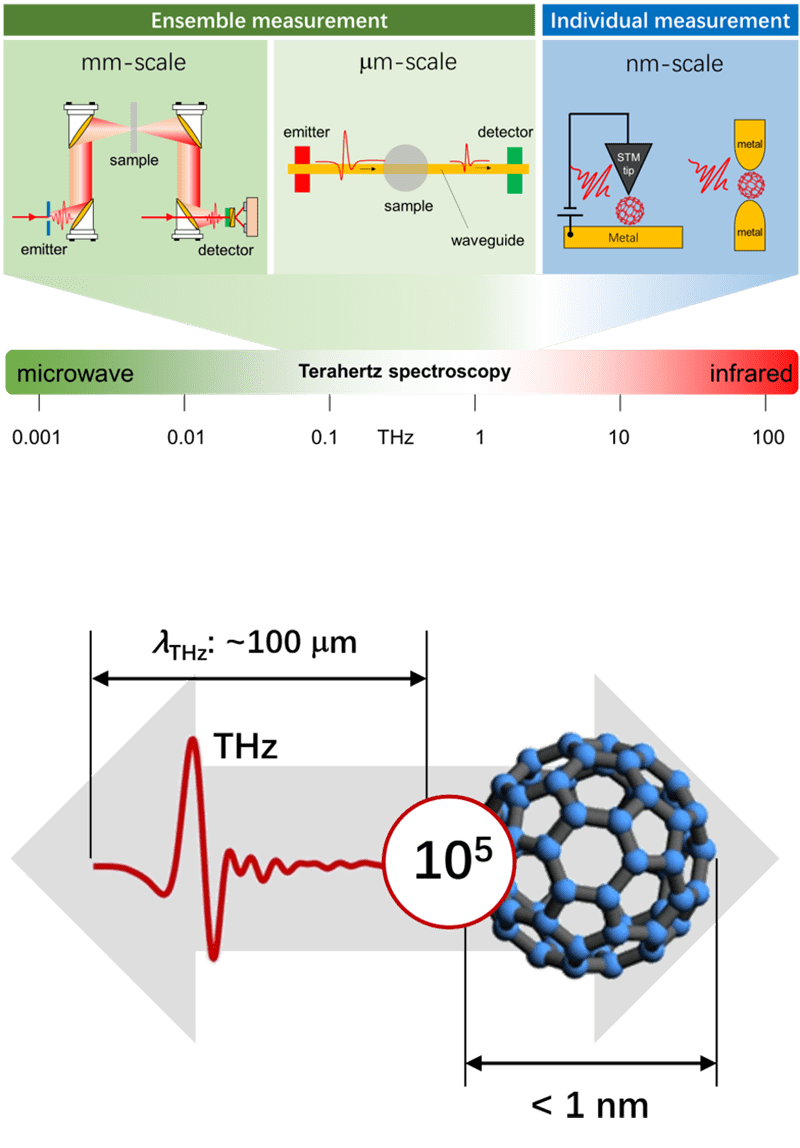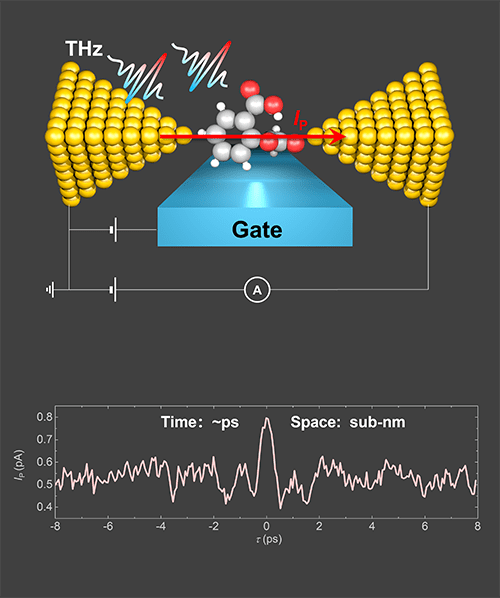Clarifying novel electronic properties of nanostructures provides key insights for future chemistry, nanoelectronics and quantum information technologies. Due to quantization of electron numbers, orbitals, and spins, quantum nanostructures show unique electronic and spintronic properties in the terahertz (THz) frequency range. We are working on physics of THz-matter interaction to explore new THz device principles at an ultrasmall nano region, i.e. single-molecule level. By characterizing and manipulating the properties of nanomaterials, we keep developing THz spectroscopy and molecular electronics.
Terahertz wave and the challenges at the nanoscale
In the past two decades, THz science and technology has played a notable role in several fields of frontier science and new technology applications, such as biology, medicine, drug detection, noval material characterization, homeland security inspection, THz communication and THz radar, etc. Recently it has become a major trend to generate overlap with related sciences and technologies in the development of THz research fields.
THz wave falls in the frequency range of 0.1-10 THz with photon energies at 0.4-40 meV. It has been clarified that the vibrational and rotational energy levels of organic and biological molecules are located in the THz frequency range. Therefore THz spectroscopy becomes a good tool to characterize their vibrational and rotational modes, and provides unique “fingerprint” spectra to identify the composition of organic materials. It has been widely used in various fields such as defense and security, chemistry, pharmacokinetics, and molecular dynamics.
Investigating material properties at the single-molecule level has become a key to the development of frontier fields. Both X-ray and visible light have enabled the observation and characterization of substances at the single-molecule scale. Although THz spectroscopy at the single-molecule level have long been sought, there are still some challenges.

THz-matter interaction at the single-molecule level
Here we face two great challenges. One is the huge difference between THz wavelength and the size of single molecules. There is a ten to the fifth times difference. So we need to go much beyond the diffraction limit and focus THz radiation onto a single molecule. The second is even we can focus THz radiation onto a single molecule. The absorption is very very small because we have only a few charges in a single molecule. Therefore we need to consider how to detect extremely weak absorption.
To overcome these problems, we use a single molecule transistor structure. The structure has the source, drain, and gate electrodes. We use these two electrodes as an antenna to focus THz radiation onto a single molecule. To enhance THz coupling, we made the shape of the electrodes like a bow-tie. Furthermore, we can detect extremely weak absorption by measuring the change in the photocurrent induced by THz illumination.
By doing so, THz spectroscopy has been successfully performed on single molecules, quantum dots, carbon nanotubes, and other low-dimensional materials, elucidating the weak interaction of THz waves with matter. We are still developing this method and expect to discover individual features in more quantum materials and explore ways to further manipulate material properties.

References
- S. Q. Du*, K. Yoshida, Y. Zhang, I. Hamada, and K. Hirakawa*, “Terahertz dynamics of electron-vibron coupling in single molecules with tunable electrostatic potential”, Nature Photonics 12, 608–612 (2018).
- S. Q. Du*, Y. Hashikawa, H. Ito, K. Hashimoto, Y. Murata, Y. Hirayama, and K. Hirakawa*, “Inelastic electron transport and ortho-para fluctuation of water molecule in H2O@C60 single molecule transistors”, Nano Letters 21, 10346–10353 (2021).
- S. Q. Du*, Y. Zhang, K. Yoshida, K. Hirakawa*, “Ultrafast rattling motion of a single atom in a fullerene cage sensed by terahertz spectroscopy”, Applied Physics Express 13, 105002 (2020).
- Y. Zhang#*, S. Q. Du#*, and K. Hirakawa*, “Deep-nanometer-scale terahertz spectroscopy using a transistor geometry with metal nanogap electrodes”, Light: Advanced Manufacturing 2, 31(2021).
- S. Q. Du* and K. Hirakawa*, Transport properties and terahertz dynamics of single molecules, in “Quantum Hybrid Electronics and Materials” (Eds. Y. Hirayama, K. Hirakawa and H. Yamaguchi), Springer (2022).

